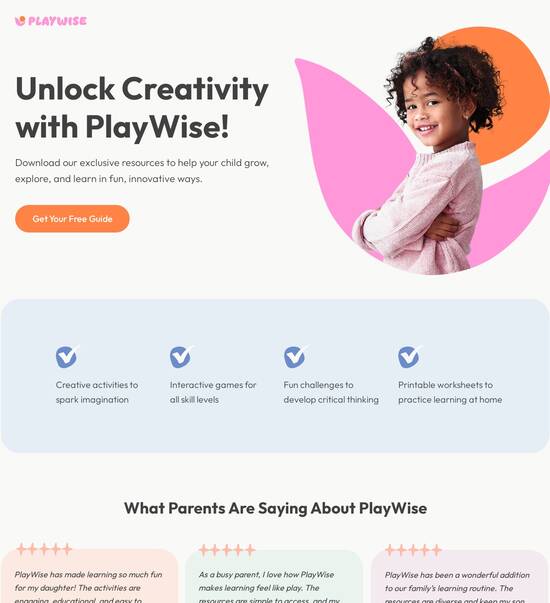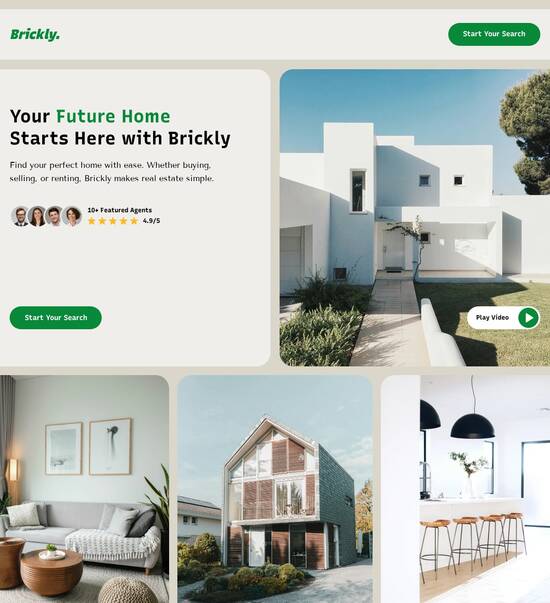
HTML page template for Account Management
Use TemplateAbout template
Conquer your niche with our high-converting landing page templates for your Account Management business. Let's boost conversion rates together!
Recommended templates

Easy to build without coding
With the intuitive drag-and-drop builder, anyone on your team can create high-converting pages without any knowledge of code or design. Make enhancements to your landing page with custom widgets using Javascript, HTML/CSS, or third-party scripts.

Multiple layouts for any industry and goal
Select from 500+ landing page layouts built to boost conversions across industry-specific scenarios. Customize them by adjusting fonts, adding images, and generating on-brand content with the AI assistant. Quickly scale with Instablocks® and Global Blocks that you can save, reuse, and update globally.

Loads fast and looks polished on any device
Every template is responsive, which means they present professionally on any device and load blazingly fast with our Thor Render Engine. You can also power them up with Google AMP technology to deliver an unparalleled mobile experience and drive higher conversions.

Robust analytics & experimentation
Get real-time updates and reporting across all your devices, showing the number of visitors, conversions, cost-per-visitor, and cost-per-lead. Launch AI-powered experiments, run A/B tests, and use heatmaps to analyze user behavior, then optimize your landing page to maximize conversions.







Easy to build without coding
With the intuitive drag-and-drop builder, anyone on your team can create high-converting pages without any knowledge of code or design. Make enhancements to your landing page with custom widgets using Javascript, HTML/CSS, or third-party scripts.
Multiple layouts for any industry and goal
Select from 500+ landing page layouts built to boost conversions across industry-specific scenarios. Customize them by adjusting fonts, adding images, and generating on-brand content with the AI assistant. Quickly scale with Instablocks® and Global Blocks that you can save, reuse, and update globally.
Loads fast and looks polished on any device
Every template is responsive, which means they present professionally on any device and load blazingly fast with our Thor Render Engine.
Robust analytics & experimentation
Get real-time updates and reporting across all your devices, showing the number of visitors, conversions, cost-per-visitor, and cost-per-lead. Launch AI-powered experiments, run A/B tests, and use heatmaps to analyze user behavior, then optimize your landing page to maximize conversions.
All the features you need to build lead-generating landing pages
Explore more featuresLearn how to build top-performing landing pages for any goal
FAQs
Leading the way in building high-performing landing pages





A comprehensive guide to using Instapage for creating effective landing pages
Creating landing pages that convert can be a challenge, but with Instapage's powerful features, marketers can easily design, optimize, and scale their digital campaigns. This step-by-step guide will walk you through the essential components of effective landing page design, highlighting why using Instapage is vital for maximizing your ROI and achieving your marketing goals.
Understanding landing page fundamentals
A landing page serves a specific purpose, such as capturing leads or driving sales. When using Instapage, it’s essential to focus on your target audience and tailor your messaging accordingly. With over 100 templates available, you can select a design that resonates with your audience's needs. Instapage focuses on creating a seamless user experience, which is crucial for reducing bounce rates and increasing conversions.
- High-converting design: Instapage templates are optimized for conversions, ensuring that every element is placed strategically.
- Responsive layouts: All landing pages are mobile-friendly, catering to users on various devices.
- A/B testing capabilities: Use this feature to determine which design elements and copy lead to better performance.
Step 1: Choosing the right template
Selecting the right template is crucial as it serves as the foundation for your landing page. With Instapage, you have access to a comprehensive library that allows you to start from a professional layout.
- Explore 100+ templates: Find a design that fits your marketing goals, whether it’s lead generation or direct sales.
- Utilize Instablocks: Make use of pre-built sections to customize your landing page efficiently without coding.
- Align your content: Ensure the template aligns with your brand messaging and target audience.
Step 2: Personalization and optimization
After choosing a template, the next crucial step is to personalize your landing page content. Instapage's advanced features allow you to create highly targeted landing pages based on user data.
- Dynamic text replacement: Tailor your messaging according to user queries and search terms.
- AdMaps: Align specific ads with unique landing pages for a cohesive marketing strategy.
- Analytics dashboard: Monitor on-page behavior and conversions using detailed analytics to ensure continuous optimization.
Step 3: Collaborating for better results
Effective collaboration is key to producing high-quality landing pages in a timely manner. Instapage provides tools that cater explicitly to team collaboration.
- Instant feedback features: Quickly share ideas and feedback within your team or with clients.
- Real-time edits: Make changes on the fly, reducing the time taken for revisions.
- Stakeholder sharing: Securely share your landing pages with stakeholders for approval before publishing.
By following these steps, you can create highly effective landing pages using Instapage, tailored to meet the unique needs of your target audience and optimized for conversions.
Ready to maximize your ROI with powerful landing pages? Sign up for Instapage today and start transforming your digital marketing strategy.
People also ask about HTML page template for Account Management
HTML page template for account management
Understanding the importance of HTML page templates in account management
HTML forms the backbone of web applications, making it essential for account management systems. By leveraging HTML's capabilities, businesses can create interfaces that are user-friendly and efficient. The role of HTML goes beyond simple structure; it provides a foundation for functionalities that enhance user interactions and overall performance.
Standardized HTML page templates help streamline the user experience, ensuring that all users benefit from a familiar layout and navigation. This consistency leads to improved usability as users can easily find what they need without having to relearn how to navigate different parts of the system. Furthermore, these templates improve performance and scalability by allowing for quicker updates and modifications across the platform.
Aesthetics play a crucial role in any web application. Beautiful design combined with functional elements creates a positive user experience, strengthens brand identity, and aids in user retention. Well-designed templates showcase content attractively, engaging users and encouraging them to explore further.
Key features of HTML page templates for account management
When creating HTML page templates, several essential features should be prioritized to ensure they meet diverse user needs effectively.
Responsive design framework
Responsive design is vital in today’s multi-device environment. Mobile-responsive layouts adapt seamlessly to different screen sizes, enhancing user experiences on smartphones, tablets, and desktops. Implementing flexible grids and CSS media queries allows for this compatibility.
Customizable block templates
Block templates consist of reusable sections that can be tailored to reflect the brand's image and meet specific user needs. Modifying these blocks enables businesses to maintain branding consistency and adapt to various marketing strategies.
Template editor functionalities
Intuitive template editors facilitate the customization process. Features such as drag-and-drop capabilities allow users, even those with little coding experience, to create personalized layouts efficiently, increasing accessibility for all skill levels.
Crafting an effective HTML page template for account management
Creating an effective HTML page template requires careful consideration of its structure and components. Key elements include headers, footers, navigation menus, and content areas, all of which should work harmoniously to provide users with essential information and options at a glance.
Incorporating visually appealing icons and graphics can significantly enhance user engagement. Well-chosen icons not only complement the text but can also provide visual cues that aid in navigation and comprehension. Through thoughtful integration of such elements, you can offer a richer user interface that attracts and retains users.
Furthermore, CSS plays a crucial role in enhancing the visual appeal of templates. Effective CSS practices can aid in the delivery of a polished and professional appearance. Utilizing CSS properties such as flexbox for layout and transitions for interactive elements can make the experience smoother and more engaging for users.
Dynamic content integration through APIs can further personalize user experiences. By fetching user-specific data, such as recent transactions or profile updates, templates can automatically adjust to meet individual user needs, thereby enhancing satisfaction and usability.
Exploring specific HTML template types for various business needs
Different businesses have unique requirements for account management templates. Understanding these needs allows businesses to choose or design templates that cater to specific functions.
E-commerce focused templates
These templates often integrate features like shopping carts and payment systems. They allow users to manage their accounts while simplifying the purchasing process, which is crucial for improving sales.
Business portfolio templates
For those in professional services or creative industries, structuring templates to showcase achievements and projects is essential. A focus on user interface (UI) and user experience (UX) in these templates can enhance client interactions and build trust.
General purpose web design templates
Their versatility allows businesses across various industries to leverage HTML templates effectively. Specific design considerations may vary based on the sector, but the foundational layout principles remain the same.
Benefits of using HTML templates for account roadmaps
One of the major advantages of utilizing pre-designed HTML templates in your account management strategy is the time saved during development. Leveraging existing templates enables teams to hasten their workflows while focusing on content and functionality rather than building pages from scratch.
Additionally, using templates can lead to significant cost savings. By minimizing the time spent on design and development, businesses can allocate resources more effectively, potentially investing in marketing efforts or user acquisition instead.
Collaboration among multiple contributors is also enhanced through the use of HTML templates. Standardized design elements ensure consistency across the platform, enabling teams to work in harmony. Features that allow multiple users to edit and review templates simultaneously streamline the process further, fostering a productive workflow.
Best practices for implementing HTML page templates
When implementing HTML templates, it is crucial to consider SEO optimization. Designing templates with search engine-friendly elements—such as meta tags, headings, and alt texts—can significantly enhance visibility in search engine results, attracting more traffic to the account management portal.
Improving accessibility in your templates is equally important. Including features that assist users with disabilities ensures that your services are accessible to everyone. Utilizing ARIA roles and attributes to describe elements helps improve usability according to the standards set forth by the Web Content Accessibility Guidelines (WCAG).
Finally, testing and iterative design are key to maintaining optimal performance. Consistently engaging in A/B testing for different template designs can yield valuable insights into user preferences. Regularly updating designs based on user feedback and analytics will improve overall satisfaction and engagement over time.
The future landscape of HTML templates in account management
Emerging trends in HTML and web design are paving the way for the future of account management templates. The integration of artificial intelligence (AI) into templates can automate various functions and offer personalized user experiences.
As the demand for customized experiences grows, businesses must adapt their designs to offer flexibility. Future iterations of templates need to cater to different user preferences while maintaining a cohesive design language.
Moreover, ensuring compatibility with evolving web standards, such as progressive web apps (PWAs), will be crucial. Templates should be adaptable to these advancements to meet user expectations for speed and responsiveness.
Real-world case studies: successful implementations of HTML page templates
Examining examples of businesses that effectively utilized HTML templates can provide valuable lessons for others. For instance, an e-commerce platform successfully implemented HTML templates that streamlined their user experience. This move resulted in significant growth in sales due to enhanced user engagement and easier account management.
In another case, a portfolio website redesigned its account management templates, which led to improved client interactions and ease of navigation for potential customers. This evolution not only attracted more clients but also fostered better communication, effectively enhancing their freelancing opportunities.
Key takeaways from these case studies include understanding user needs and the importance of maintaining an intuitive design. It's also critical to identify common pitfalls, such as overwhelming users with too much information or design elements that distract rather than facilitate.
Choosing the right HTML template for your requirements
Evaluating template features against your business needs is paramount when selecting the ideal HTML template. Key questions to consider include: What functionalities do you require? How customizable does the template need to be? Understanding these requirements will guide you toward choosing a template that aligns with your objectives.
Comparing template vendors based on factors such as support, customization options, and user reviews can provide insights that facilitate informed decisions. Consider the long-term implications of your choice, as a well-suited template can evolve with your business.
The debate between customization and ready-made templates also merits consideration. While fully customized templates may meet specific needs, they can also require significant time and resources to develop. On the other hand, ready-made templates can expedite development but may lack the tailored features your business desires. Balancing these factors is essential in your overall account management strategy.
Practical tips for designing your own HTML page templates
When designing your own HTML templates, applying user-centered design principles is essential. Conducting user research can provide insights into user preferences, behaviors, and pain points, which can inform your design choices. Involving actual users during the testing phase also ensures that the design is effective and meets user needs.
Another important aspect is the art of minimalism in template design. By adopting a minimalist approach, you can reduce cognitive load on users, allowing them to focus on essential tasks. Examples of successful minimalist templates illustrate how simplicity can lead to improved user experience without compromising on functionality.
Ready to skyrocket conversions?
Supercharge your ad campaigns with high-performing landing pages
Get started














